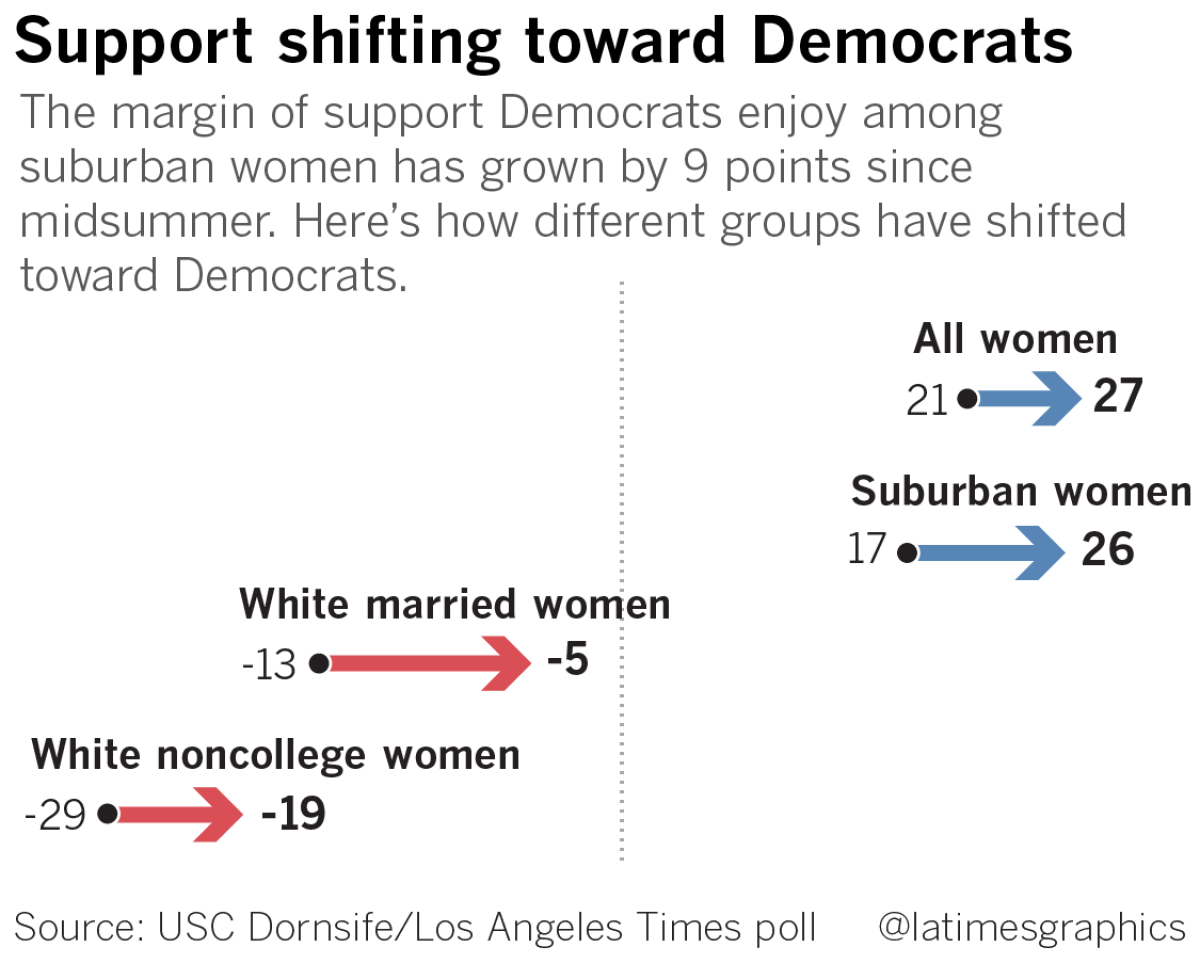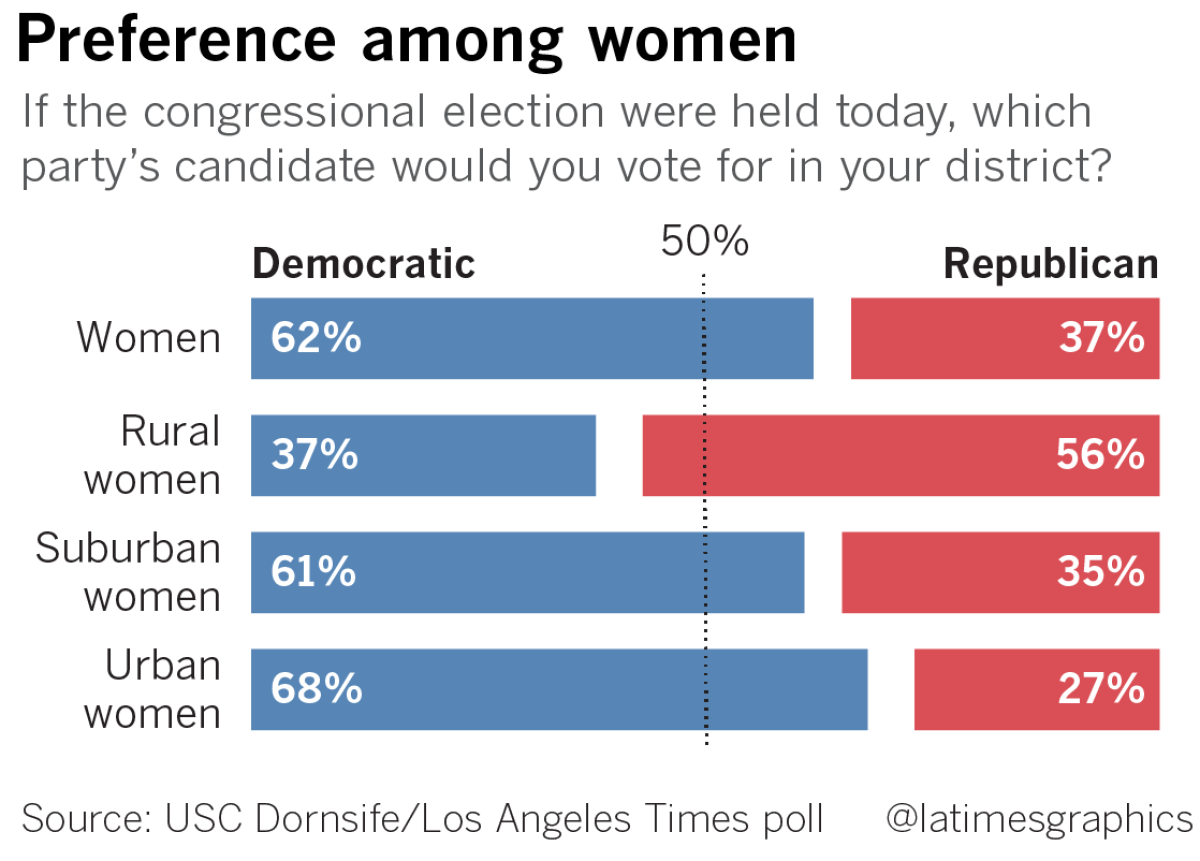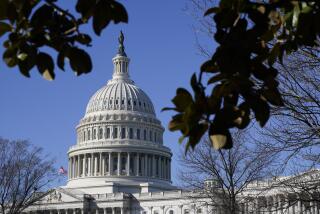With growing support from women, Democrats poised for major gains in midterm, new poll shows

Boosted by growing support among suburban women and widespread antipathy toward President Trump, Democrats approach the midterm election poised to make major gains nationwide, a new USC Dornsife/Los Angeles Times Poll shows.
Democrats had a 14-point margin, 55% to 41%, when likely voters were asked which party’s candidate they would cast a ballot for if the election were held now. If that advantage holds up until election day, just less than six weeks away, it would almost surely be large enough to sweep a Democratic majority into the House.

Voters also oppose Republicans on a number of major issues. But overriding all of them is the president, whose outsized personality has dominated the nation’s news since he declared his candidacy more than three years ago.
Roughly 3 out of 4 likely voters said they saw their vote this fall as an opportunity to express a view of Trump. For many, that view is negative: Those saying they planned to register opposition outnumbered Trump supporters, 45% to 29%.
Likely voters disapprove of Trump’s overall performance in office by 57% to 39%, the poll found. Almost half of likely voters, 49%, said they “strongly” disapprove, while just under one-quarter, 24%, strongly approve.
Especially notable are the views of women, whose preferences have expanded the Democratic edge since a USC Dornsife poll surveyed most of the same voters this summer.
In the summer, men were closely divided between the two parties; they remain so now. But women, who already leaned significantly toward the Democrats, have shifted further in their direction, widening a large gender gap. The poll found women now favor the Democrats by 28 percentage points, 62% to 34%, among likely voters.
Three overlapping groups of female voters who have long been important for Republicans have moved away from the party: suburban residents, married white women and white women without college degrees.
Democrats enjoy a 61%-35% edge among suburban women, the poll found — a margin that has grown by 9 points since the summer. Democrats have narrowed the gap with Republicans among married white women, long a mainstay of the GOP, who now favor Republicans by a narrow 51% to 46%.

Those numbers help explain why suburban congressional districts long held by Republicans — from Orange County and Santa Clarita to the suburbs of Dallas and Houston and east to suburban Philadelphia — have become key targets in Democrats’ effort to retake control of the House.
A similar pattern holds among white women who did not graduate from college. Blue-collar white women gave Trump a crucial margin of support in 2016. A majority continues to support Republicans — by 56% to 39% — but since the summer, Democrats have cut their deficit with that group by a third.
The poll was largely completed before accusations of sexual misconduct against Judge Brent Kavanaugh, Trump’s nominee to the Supreme Court, began dominating the news. Many political professionals in both parties think that controversy could further alienate women from the GOP.
Especially striking: Democrats have also made significant gains among older voters, a bastion for Republicans over the last two decades. Among likely voters 65 and older, Democrats lead 51% to 45%.
“That’s very disturbing” from a Republican standpoint, said longtime party strategist Mike Murphy, the co-director of USC’s Center for the Political Future. “If Republicans are not doing well with seniors and not doing well with college-educated voters in the suburbs, there’s just no good news” for the party, he said.
One factor not driving the vote: the economy. Republican congressional leaders had hoped to build their campaigns around the current economic good times, but that message has largely been drowned out by the noise surrounding the White House.
“It’s striking how little the economy seems to be driving the vote,” said Robert Shrum, the Center for the Political Future’s other co-director and a longtime Democratic strategist. “I can’t think of an election in which the economy was less driving the vote.”
Voters grade Trump less negatively on his handling of the economy than on many aspects of his presidency, with opinion divided almost evenly, 45% approving and 44% disapproving. On five other areas that the poll asked about — handling of illegal immigration, trade, healthcare, race relations and the investigation into Russian efforts to interfere in the 2016 campaign — Trump’s ratings were under water.
The share of likely voters approving of Trump’s conduct ranged from 39% for his handling of illegal immigration down to just 24% on the Russia investigation. A similar 27% shared Trump’s often-expressed view that the investigation by special counsel Robert S. Mueller III is unfair. Just less than half of likely voters, 48%, said they viewed Mueller’s work as fair. About 1 in 4 said they either were uncertain or had no opinion.
Trump’s ratings for handling race relations were also notably low, with just 26% approving. Among African American voters, 91% disapproved.
Democrats need to pick up a net of 23 seats to gain a House majority. Their 14-point lead in the poll indicates they’re well positioned to hit that goal. Since congressional races are fought district by district, however, the national preference can provide only a rough forecast.
In recent elections, Democrats have won fewer House seats than their share of the national popular vote. That’s in part because Democrats tend to concentrate heavily in major cities, where their candidates often win huge majorities; the extra votes pad the national total but don’t win additional districts. Gerrymanders favoring Republicans in several states also play a significant role.

A strong enough tide for Democrats could also tip control of the Senate their way, although that goal remains more distant because seats up for election this cycle disproportionately lean Republican.
The poll’s findings line up with some other major surveys conducted in recent weeks, including an ABC-Washington Post poll in late August that also found Democrats with a 14-point lead when voters were asked which party’s candidates they expected to vote for, and an NBC-Wall Street Journal survey released Sunday that found a 12-point lead.
Midterm elections usually act as a referendum on the party in the White House. That’s even more true now because of the way Trump has insistently put himself on center stage. For his adopted party, he has become a significant drag.
While Trump has dominated the GOP since he conquered its establishment in the 2016 primaries, a small yet significant share of Republican voters still dissents.
Reflecting that split, Republican-leaning voters show less unity in support of the party’s candidates than Democratic-leaning voters show toward that party’s choices. The Republican defections are not huge, but could make the margin of victory in close contests.
Nearly 9 in 10 voters who said they typically side with Democrats strongly disapprove of Trump. About 6 in 10 of those who typically side with the GOP strongly approve of him.
Underscoring just how central the president is to the midterm outlook, 8 out of 10 voters who favor or lean toward Democrats said they saw their vote as expressing opposition to Trump, while about two-thirds of voters who favor or lean toward Republicans said the opposite.
The same divisions cropped up when Republican voters were asked about the future. More than a third said they would like to see another candidate challenge Trump for the presidential nomination in 2020. That’s an unusually large figure this early in a president’s term, said Shrum, who worked for Sen. Edward M. Kennedy of Massachusetts when he challenged President Carter for the Democratic nomination in 1980.
Trump has not expanded his base of support. His strongest backing continues to come from white men without college degrees, rural residents and white evangelicals. That last group makes up about 1 in 5 likely voters.
Opposition to Trump — and support for Democrats — hits its peak among women with college degrees, urban residents and minorities, especially African Americans.
Both men and women in rural areas favor the GOP, while in the cities, both favor Democrats. The gender gap is in the suburbs, where most women disapprove of Trump and favor Democrats, and most men take the opposite views.
Voters on either side of the partisan divide have notably different priorities on issues. Asked to pick from a list the one issue they considered most important, Democratic voters put healthcare at the top, followed by the economy and jobs. Republican voters put the economy and jobs at the top, followed by taxes and spending and illegal immigration.
Immigration’s ranking as a top priority for many Republicans has put the party in a difficult bind: Several positions advocated by its immigration hard-liners and the administration are rejected by the rest of the country.
Trump, for example, has proposed measures to reduce legal immigration. That’s backed by some of his strongest supporters and key administration figures, but by only about 2 in 10 likely voters.
Roughly half of likely voters want to keep the level of immigration as is, while about 3 in 10 would like to see it increase.
Similarly, by 78% to 18%, likely voters supported allowing people who came to the U.S. illegally as children to stay and eventually apply for citizenship, a position the administration has opposed. More than 4 in 10 likely voters strongly support a path to citizenship.
Voters divided closely on whether illegal immigration is among the country’s most serious problem: 48% ranked it as the most, or one of the most, serious; 44% called it a problem, but not one of the most serious, and 6% said it’s not a problem at all.
Forget Trump and demonize Democrats as wild-eyed radicals — that’s the Republican midterm strategy »
About one-third of likely voters supported the hard-line view that all immigrants in the country without legal authority should be deported. About one-quarter would deport anyone who had been convicted of a crime, while roughly another third would deport only those convicted of serious crimes — roughly the position the government took in the final years of President Obama’s tenure. Only 3% said no one should be deported.
Just 40% supported Trump’s call to build a wall along the border with Mexico — one of his signature proposals. Support falls slightly, to 37%, if taxpayer money is used.
Trump repeatedly has said Mexico would pay for the wall, but the administration has asked Congress for $5 billion to begin construction. So far, Congress has refused.
The president will need to decide in the next several days whether to sign a government funding bill that would provide money to keep federal agencies open in the new fiscal year, which starts Monday, but would not include funds for the wall. He has periodically threatened to shut down the government rather than accept that, but the poll suggests most voters would object.
This USC Dornsife/Times poll, overseen by survey director Jill Darling and co-sponsored by the university’s Center for the Political Future, was conducted online among 5,045 adult Americans, of whom 2,513 were deemed likely to vote this fall.
The poll respondents were drawn from a probability-based panel maintained by USC’s Center for Economic and Social Research for its Understanding America Study. Responses were weighted to accurately reflect known demographics of the U.S. population. The survey was conducted Aug. 22-Sept. 24. The margin of error for the likely voter sample is 2 percentage points in either direction. A full description of the methodology, poll questions and dataare posted on the USC website.
Get the latest news from the nation’s capital on Essential Washington >> »
For more on Politics and Policy, follow me @DavidLauter
More to Read
Get the L.A. Times Politics newsletter
Deeply reported insights into legislation, politics and policy from Sacramento, Washington and beyond. In your inbox three times per week.
You may occasionally receive promotional content from the Los Angeles Times.







